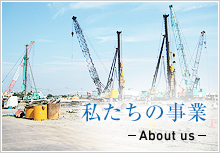2007.08.01
LIQUEFACTION−INDUCED DAMAGE TO BUILDINGS IN 1990 LUZON EARTHQUAKE(ASCE1994)
Kohji Tokimatu(Tokyo Inst.of Tech)・Hisaya Kojima(Tokyo Inst.of Tech)・Shinichi kuwayama(GEOTOP)・Akio Abe(Tokyo Soil Research)・Saburoh Midorikawa(Tokyo Inst.of Tech)
■掲載誌:ASCE GT,p290-307
■発行所:ASCE
■発行:1994/2
The Luzon Earthquake of 1990 (M. = 7.8) caused soil liquefaction in a widespread area that in turn caused crucial damage to various structures. After presenting an overview of the geotechnical aspects of the earthquake, this paper describes damage patterns of buildings in Dagupan City where fine to silty sands liquefied extensively. Also presented are geomorphological conditions, Standard Penetration Test (SPT) results, and shear wave velocity (V.) profiles determined by a Rayleigh wave method; and their relations to the building damage of the city. The buildings that suffered large settlement and tilting are found to be concentrated in the banks of active rivers and in the fills built on recently abandoned river channels. It is found that the currently available empirical correlations using SPT N-value can well estimate the extent of liquefaction-induced damage to buildings. The Rayleigh wave method used shows capability in determining cross sections of V, structure in the near surface soil.
■発行所:ASCE
■発行:1994/2
The Luzon Earthquake of 1990 (M. = 7.8) caused soil liquefaction in a widespread area that in turn caused crucial damage to various structures. After presenting an overview of the geotechnical aspects of the earthquake, this paper describes damage patterns of buildings in Dagupan City where fine to silty sands liquefied extensively. Also presented are geomorphological conditions, Standard Penetration Test (SPT) results, and shear wave velocity (V.) profiles determined by a Rayleigh wave method; and their relations to the building damage of the city. The buildings that suffered large settlement and tilting are found to be concentrated in the banks of active rivers and in the fills built on recently abandoned river channels. It is found that the currently available empirical correlations using SPT N-value can well estimate the extent of liquefaction-induced damage to buildings. The Rayleigh wave method used shows capability in determining cross sections of V, structure in the near surface soil.

